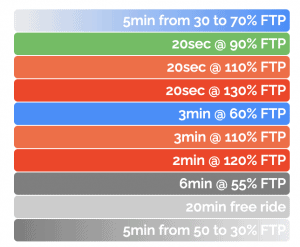So what is an FTP test?
An FTP test is a way of determining your current cycling performance level. FTP stands for Functional Threshold Power and it’s a measure of the best average power output you could sustain for a set time.
There are lots of ways to determine your FTP (see below). One popular method is to do a 20 minute time trial and then take that number and divide by .95 to figure out your zones. (Thankfully both Final Surge and Training Peaks will figure it out automatically.)
Functional Threshold Power is the amount of power you can sustain for a set amount of time. FTP is your Zone 3.
Why do you need to do it?
If you are looking to improve your power over the course of a season, then doing these FTP tests do help you improve.They also give you a gage of where you are at.
How do they work?
On Zwift, there is a short FTP test that is only 45 minutes. At first, you warm up for 5 minutes at 30 percent of your FTP or Zone 1. Then you go through a series of bursts of above FTP before starting your 20 minute free ride, where you go out the hardest that you can for 20 minutes.
Here is a screen shot from Zwift’s short FTP Test:

You can also do this outside. If you do it outside, here is what you do:
Ride for about 20 minutes or so and get a good warm-up. During that warm up try to do short 20 – 30 second bursts of speed. Keep those RPMs high during the speed intervals.
Then, once you are warmed up, you can go out for 20 minutes as hard as you can. (There are some that do 8 minute x2 and then take an average. But the standard is 20 minutes.)
Look at your power during that time and take an average power reading. Then, multiply that by .95 and that is your FTP.
If you don’t have a power meter
If you have Zwift or any other smart trainer like Peloton, you may be able to do it through the app. Or, you can do it at the gym on a stationary bike. It won’t be 100% accurate but at least you will have a basis on where you are at. You can also do it with a HR monitor but again, it’s not as accurate a test if you don’t have an actual power meter.
Let me know if this is helpful!





